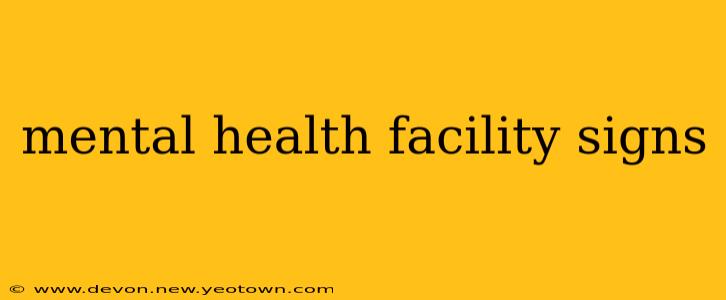Finding the right mental health facility can be a daunting journey, filled with uncertainty and anxiety. Clear, compassionate signage plays a crucial role in guiding individuals and their families to the support they need, while simultaneously creating a safe and welcoming environment within the facility itself. This goes beyond simply pointing the way; it's about fostering a sense of calm and understanding during a vulnerable time.
Let's explore the critical aspects of mental health facility signage, examining best practices and the subtle nuances that can significantly impact the experience of patients, visitors, and staff.
What are the key considerations for designing mental health facility signs?
Designing effective signage for a mental health facility requires a thoughtful approach, considering both practical and emotional factors. The goal is to create signs that are not just informative but also supportive and reassuring. This means selecting the right fonts, colors, and wording to create a calming and accessible atmosphere. Consider factors like:
- Clarity and Simplicity: Avoid jargon. Use clear, concise language that is easy to understand, even for someone experiencing distress.
- Accessibility: Ensure signs meet accessibility standards for individuals with visual impairments (e.g., braille, large print). Consider diverse literacy levels as well.
- Cultural Sensitivity: Use inclusive language that respects diverse cultural backgrounds and avoids potentially offensive terms.
- Visual Appeal: Choose calming colors and fonts. Avoid overly bright or jarring designs that might increase anxiety.
What types of signs are typically found in mental health facilities?
Mental health facilities require a variety of signs to ensure smooth operation and patient safety. Common types include:
- Directional Signs: These guide visitors to different areas of the facility, such as reception, waiting rooms, therapy rooms, and administrative offices. Clear and consistent wayfinding is essential.
- Informational Signs: These provide crucial details about facility policies, hours of operation, emergency procedures, and contact information.
- Regulatory Signs: These address safety regulations and compliance requirements, including fire exits, emergency exits, and security protocols.
- Patient Room Identification: Signs clearly identifying patient rooms are essential for staff and visitors. Privacy considerations are paramount; these signs may need to be discreet yet easily readable by authorized personnel.
- Wayfinding Signs for Outdoor Areas: If the facility has outdoor spaces, clear wayfinding signs are needed for safe navigation.
What makes a good mental health facility sign different from other signs?
The key difference lies in the sensitivity required. Mental health facilities serve individuals who may be experiencing emotional distress or vulnerability. Therefore, signage should be designed to minimize stress and promote a feeling of safety and calm. This means:
- Compassionate Wording: Signs should use reassuring and supportive language. Instead of commands, opt for phrases that encourage cooperation and understanding.
- Calm Color Palette: Avoid bright, stimulating colors. Opt for softer, calming hues like blues, greens, and soft grays.
- Clear Font Selection: Choose easy-to-read fonts that are not overly stylized or difficult to decipher. Legibility is paramount.
What are some examples of effective wording for mental health facility signs?
Instead of stark directives, consider phrasing like:
- "Welcome, we're here to help."
- "Quiet Zone - Please Speak Softly."
- "Emergency Exit - Proceed to Safety."
- "Reception - Please Check In Here."
What are the legal requirements for signage in mental health facilities?
Legal requirements for signage vary by location and jurisdiction. It's essential to comply with all applicable local, state, and federal regulations. These often relate to:
- Accessibility standards (ADA compliance): Ensuring signs meet accessibility guidelines for individuals with disabilities.
- Fire safety regulations: Clear and visible emergency exit signs are mandated.
- Health and safety regulations: Signs addressing specific health and safety concerns, depending on the services offered by the facility.
How can signage improve patient experience in a mental health facility?
Well-designed signage contributes to a positive patient experience in several key ways:
- Reduced Anxiety: Clear, reassuring signs can lessen feelings of confusion and anxiety.
- Improved Wayfinding: Easy-to-understand directional signs reduce frustration and stress.
- Enhanced Safety: Clear safety and emergency signage improves safety and response times in critical situations.
- Increased Sense of Calm: A calming environment, achieved through thoughtful signage design, can positively impact patient wellbeing.
Creating effective signage for mental health facilities is more than just meeting regulatory requirements; it's about crafting a welcoming and supportive environment that prioritizes the emotional wellbeing of patients and staff. By carefully considering the design elements discussed here, facilities can significantly improve the overall experience and contribute to a more healing and therapeutic atmosphere.

